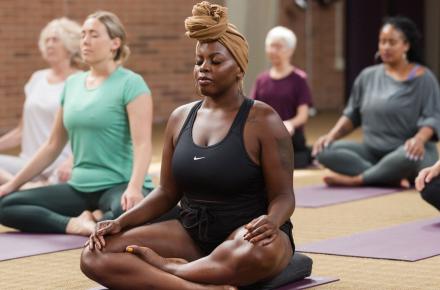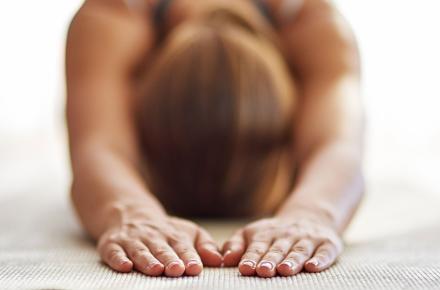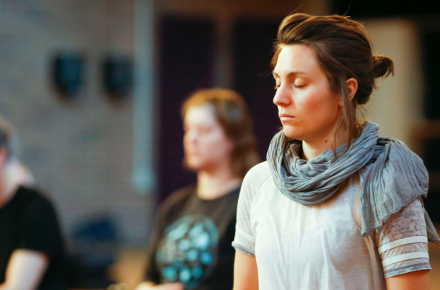An Exercise for Accessing Playfulness and Delight in Meditation

Recently I was watching my six-year-old niece play on the beach, running toward the water when a wave receded and running back toward me howling when the next wave crashed on the shore. Her sheer delight was palpable and infectious, and I was fully present, riveted on what was happening. In this moment of clarity, I closed my eyes and wondered why this sense of vibrancy and joy was not somehow encouraged in meditation instructions.
Not long after the beach experience, I had occasion to ask a colleague why he struggled to meditate regularly. He said, “Because it’s not fun—that’s why!”
Even though we all claim to understand the importance of play to our well-being, somewhere along the way our inner playful child gets lost in the shuffle. A sense of play is certainly absent in meditation, which in my view is a major cause of frustrating, uninspired practice.
Playfulness and its accompanying sense of delight are vital qualities of the inner holding environment needed for meditation. Our cultural inclination is to be overly serious about most things, including meditation. Meditation instructions can conjure up the imagined need for serious, brow-furrowing effort, with a sense that there is an ideal or “right” way to practice. They often include directions such as “focus the attention,” “bring the mind back,” “label,” “dis-identify,” “concentrate,” “tame the mind,” “overcome obstacles,” “establish moment-to-moment attention without censorship.” These words of guidance are dry and uninviting for most people, and those such as “sit still” and “pay attention” dredge up unhappy home or schoolroom memories. “Sit still, pay attention, and eat your green vegetables,” my mother would admonish.
Participating in any activity that is foreign but supposedly good for us is reminiscent of having to take that really bad-tasting cough medicine as a kid. I still remember the time I had strep throat and the disgusting taste of liquid antibiotics. My mother’s reassurance, “That’s OK; it’s good for you,” just didn’t fly. I needed something sweet.
Relaxation and delight add a spoonful of sugar, a sense of comfort and sweetness to the inner milieu. I suggest putting these first in meditation, rather than viewing them as mere by-products that may arise later in our practice. We want to feel good as soon as possible. This is the best possible enticement for learning and continuing with meditation.
The Buddha encouraged this spoonful-of-sugar approach by introducing calming practices to his students. These stabilizing techniques were clearly prerequisites for mindfulness practices, leading to deeper understanding and insight. There are many descriptions of the sweetness, the sukha, of concentrated states of mind and how they are more deeply satisfying than sensory pleasures.
Westerners have trouble accessing sukha in this classic manner, because it takes us hundreds of hours of formal practice in a retreat environment to begin to access these states. We can, however, with far less practice and some creativity, begin to consciously experience some degree of relaxation and delight without external support. Learning how to create a sense of lighthearted ease within a few minutes can be a simple act of self-care in meditation.
A few preliminary tips about practicing the technique that follows:
- Remember to allow yourself to feel settled, letting the breath be soothing.
- Typically, the initial images that come to mind are not clear or steady, and at times may seem random and disconnected. Remember, however, that the imagery that arrives is simply a gateway for allowing the joyful feelings associated with the memory to arise. This is what matters, not the precision of the memory or image.
- You cannot fail at this exercise! Remember: this is a practice. Sometimes delight will arise fleetingly, and you might try to get it back using control, which creates tension. Delight cannot be coerced; focus on relaxing and allowing the feelings to return or not.
Playfulness Exercise
- First, establish some degree of relaxation and ease in the body and breath, as if you are sitting in a warm and comforting bath, feeling the small knots of tension dissolving, letting go, more and more, with each breath. Take your time to relax.
- When you feel relaxed and your breath is easy, allow a memory of a happy moment to arise, one in which you were filled with delight and the energy that brings.
- Continue to allow your breath to be natural and relaxed; stay with any flow of images and perhaps sounds associated with this memory scene.
- As the memory unfolds, bring attention to how you felt during that experience. Let yourself savor the delight or joy or exuberance. Allow these feelings to spread throughout your body and mind. Let an inner smile form as you feel them.
- As the sense of delight strengthens, let go of the imagery, sitting and breathing in this atmosphere of playful ease and relaxation that has been created. If tension creeps in or the mind gets carried off in a thought stream, simply return again to the flow of imagery of this uplifting scene.
- When you are ready, return to a normal waking state, continuing to enjoy the feelings.
We are drawn to feeling relaxed and lighthearted. If we elicit these core qualities at the beginning of meditation practice, meditation will become a less intense, more upbeat part of our repertoire.
This article is adapted from The Meditator’s Dilemma, by Bill Morgan, © 2016, Shambhala Publications, Inc.
















































